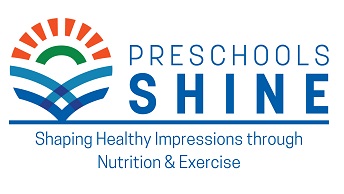SHINE Element 4: Nutrition Education
Overview
Guidance for implementing the criteria for Element 4, Nutrition Education, of the Preschools Shaping Healthy Impressions through Nutrition and Exercise (SHINE) program.
Criteria for Element 4, Nutrition Education
- Provide nutrition education experiences a minimum of twice monthly.
- Promote healthy foods and beverages at the child care site.
- Create a culturally inclusive food environment.
Eating habits do not occur by accident; they are learned. During their early years, children form eating habits that will last a lifetime. Therefore, nutrition education must be an important part of child care curricular activities. Nutrition education provides children with meaningful opportunities to experience healthy foods and develop knowledge and skills needed to make appropriate food choices. Teachers and family child care providers can support positive eating habits by creating healthy nutrition environments and providing positive food experiences to help young children enjoy healthy, nutritious foods.
Follow the practices below to meet the criteria for Element 4
- Provide nutrition education experiences a minimum of twice monthly
Choose one of the nutrition education curricula listed below, or select one that is: (1) aligned with the Dietary Guidelines for Americans to help children develop an awareness of good nutrition and healthy eating habits, and (2) encourages school readiness by incorporating mathematics, science, and language arts, literacy, and social studies:
- Colorado's Healthier Meals Initiative (HMI) toolkit, developed by Colorado Department of Public Health & Environment (CDPHE), helps improve the diets and health of children in your care through an activity guide booklet, cooks guide, menus and recipe guide. This curriculum is available on the CDPHE Colorado's Healthier Meals Initiative.
- The Child Health Initiative for Lifelong Eating and Exercise (CHILE) Plus program provides nutrition and physical activity education to reduce screentime for preschool age children and to help educate their families. The toolkit includes classroom nutrition and physical activity materials, newsletters, activities and recipes for families to take home. This curriculum is available on the SNAP-ED Toolkit Obesity Prevention Interventions and Evaluation Framework, CHILE Plus web page.
- Cooking Matters teaches child care providers and parents to shop smarter, use nutrition information to make healthier choices and cook delicious, affordable meals for children in their care. Lessons include practicing proper knife techniques, reading ingredient labels, and making a healthy meal for families on a budget. This curriculum is available on the SNAP-ED Toolkit Obesity Prevention Interventions and Evaluation Framework, Cooking Matters web page.
- Grow It, Try It, Like It!, developed by the U.S. Department of Agriculture (USDA) Team Nutrition (TN) initiative, is a garden-themed nutrition education kit that introduces children to three fruits and three vegetables. The kit includes seven booklets featuring fruits and vegetables with fun activities through the imaginary garden at Tasty Acres Farm! This curriculum can be downloaded for free on the USDA TN Grow It, Try It, Like It! Nutrition Education Kit Featuring MyPlate web page.
- Make sure all teachers and providers are trained in the use of the curriculum.
- Do not use curricula, books, or resources that contain logos or brand names of foods and beverages with little nutritional value.
- Reinforce nutrition education at mealtimes. Model healthy eating, eat the same mealtime foods as the children, and talk about the meal or snack.
2. Promote healthy foods and beverages at the child care site by implementing a minimum of one of the strategies listed below:
- Post pictures of healthy foods on the walls, provide storybooks that depict healthy nutrition messages, and include models of nutritious food and kitchen equipment in the site’s dramatic play area.
- For fundraising activities, sell nonfood items or only healthy foods.
- Provide a minimum of two cooking activities or food tastings each year. These activities are excellent ways for children to develop an appreciation for a variety of foods. They allow children to explore foods through the use of their senses.
- Take a minimum of two field trips to farmers’ markets, farms, orchards, or local bakeries and other food venues. To locate a farmers’ market in your area, visit the California Department of Public Health Farmers’ Markets web page.
3. Create a culturally inclusive food environment by implementing a minimum of one of the strategies listed below:
- Include foods that reflect cultural diversity in the nutrition education curriculum.
- Add models of healthy foods from a variety of cultures in the site’s dramatic play area.
- Provide storybooks that include foods from various cultures.
- Ask families a minimum of once each year to share healthy cultural recipes that children can prepare as a cooking activity.
- Use recipes to create cultural foods that children enjoy. To find child care recipes that include a variety of cultural flavor profiles and Child and Adult Care Food Program meal pattern crediting information, access the ICN Child Nutrition Recipe Box web page.

This institution is an equal opportunity provider.
Esta institución es un proveedor que ofrece igualdad de oportunidades.
Last updated: January 2022